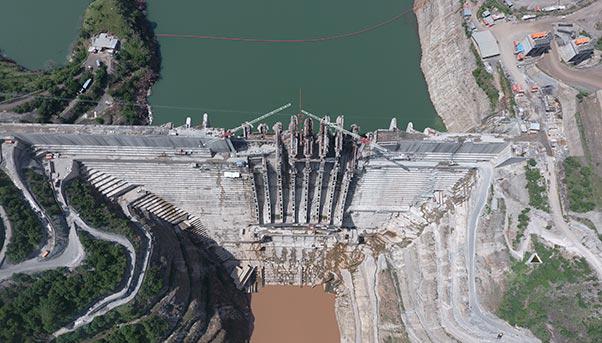Gibe III is finally complete. On December 17, 2016, the hydroelectric dam on the Omo River (the largest until work is finished on the GERD, also in Ethiopia) will be inaugurated. Built by Salini Impregilo and financed by the Ethiopian Electric Power, the state energy company, and the Export-Import Bank of China with a commitment of €1.47 billion, it is nearly 300 kilometres southwest of the capital Addis Abeba. Only a few numbers are needed to reveal the majestic size of the project: the open-air power plant has 10 Francis turbines with a total installed capacity of 1,870 MW and an expected output of 6,500 GWh per year. The complex comprises three diversion tunnels, two intake structures, four vertical shafts and two distributors, among other features. At 250 metres in height, it is the tallest in the world, built with roller-compacted concrete (RCC), requiring the expertise of people of the highest level. Engineers, technicians, mechanics, carpenters… all of them gave their best to build this giant whose size displays an ambition to leave its mark on the country.
And so it has come to be. Nearly 10 years in the making, Gibe III represents Ethiopia’s push to industrialize its economy, a country whose desire to modernize is seeing it push ahead with the construction of yet another other big dam on the Blue Nile: the Grand Ethiopian Renaissance Dam (GERD). As in the case of Gibe III, it was necessary to overcome the engineering limits of the day, developing innovative solutions that have set the standard for the world. The result is a big engineering project that serves as a fundamental instrument for development and the eradication of poverty. This is because, in terms of the impact that it will have on the country’s energy production, Gibe III represents an enormous step forward.

When it is fully operational, it will boost by 85% the amount of energy produced in Ethiopia. Half of it will be used to meet the growing demand in Ethiopia, the result of an economic boom sweeping the country. The other half will more than likely be destined for export. Kenya, Sudan and Djibouti should be the first three markets as Ethiopia positions itself to becoming a production and distribution hub for the entire region.
The latest example of the engineering prowess of Salini Impregilo in the water sector, Gibe III is a remarkable feat for Ethiopia. During its construction, it employed thousands of people (more than 8,000 people at its peak), most of them Ethiopian. It offered not only jobs but training that will help workers in the search for jobs following the completion of the project.
It is not the first project of this magnitude to have brought such benefits to the local populace. The first dams to take advantage of the potential of the Gilgel Gibe and Omo rivers date back 30 years. In 1986, work began on the first dam known as the Gilgel Gibe I. After an interruption in the 1990s, it was completed in 2004. The second dam, Gilgel Gibe II, was built between 2005 and 2010. Before its completion, work on a third had begun in 2006. It would be a more ambitious project called Gibe III. In all of these great projects, Salini Impregilo worked with the Ethiopian government to contribute to the development of the country, transforming it into an African powerhouse.

